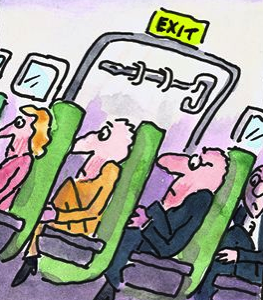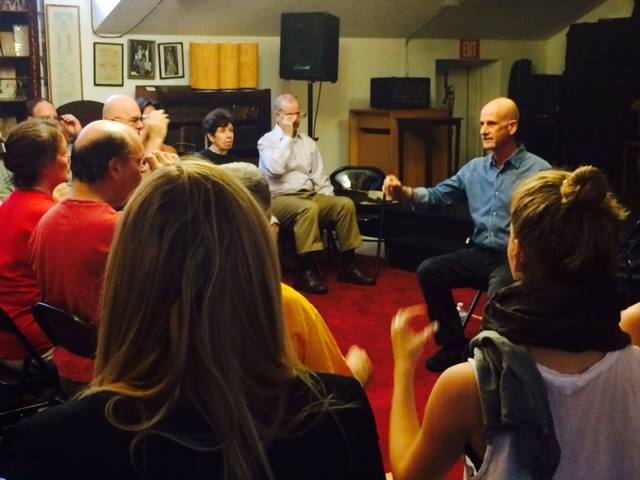
Use the Alexander Technique for Traveling
One of the many useful aspects of the Alexander Technique is its portability. The Alexander Technique is a tool you use anywhere, at any time. So when traveling, you can take the Alexander Technique with you. Think of it as a carry-on.
You can’t really use chiropractic, acupuncture, or physical therapy in the way you use the Alexander Technique. For each of those methods, and so many more, one goes to the practitioner for treatment. The Alexander Technique stays with you, and moves with you. You own the Alexander Technique, therefore the Alexander Technique makes for a perfect traveling companion.
When we are traveling we are usually seated, and often the sitting situation is not optimal. We are cramped into buses, planes, trains, or cars. All present a challenge to using the principles of the Alexander Technique, and a bigger challenge if you don’t know the principles of the Alexander Technique! Sitting for long hours tires us, as does the stress associated with traveling. It is very easy to get fall into habits that aren’t beneficial for us, habits that compress our spine, increase our muscular tension, and decrease our breathing capacity.
Slumping is all too easy when tired, bored, or jet-lagged. We collapse our neck forward and down, our ribcage compresses, and our shoulders roll forward. There is less room for our lungs to expand so we have a diminished capacity for a full exchange of oxygen, which just adds to the fatigue.
So how can we use the Alexander Method to help us while traveling?
We can become more aware of all that is getting in the way of using ourselves well (our posture) We can notice that traveling can place us in ergonomic hell, and therefore we need to become more vigilant regarding what we are doing with our body.
One of the first steps, no matter the seating situation, is to free your neck muscles. Let go of the extra tension in your neck and let your head rotate forward, and up. Think of your head taking your spine up with it, while your sitting bones are going down into the seat. If you are sitting on a soft surface such as a plane seat, this can be challenging. However, even if you can not actually feel where your sit bones are, you can imagine where they are. When you allow the sit bones to go down, you get rid of the over-straightening of your lower back in an attempt to ‘sit up straight’, which is just another version of bad posture. Think about your spine lengthening up and down, and let your breathing be slower, and fuller. If you have a chance to move, or stretch, take advantage of it.
When you arrive at your destination, take a few minutes to do some ‘constructive rest’. Lie down on the floor facing up, knees bent, with you head resting on a few books. Breathe fully, and let your torso lengthen and widen.
The more you know about the Alexander Technique, the more you can use the Alexander Technique in all aspects of traveling. The Alexander Technique is made for portability and traveling.
Your comments are always welcome.
Mark Josefsberg-Alexander Technique NYC
(917) 709-4648










Great advice, Mark! The Alexander Technique can certainly help us whatever shape we might be forced into because of cramped seats and conditions. I love that you mention doing constructive rest once you have arrived at your destination. I fly to the UK once a year to visit family (which is an overnight flight in a cramped airplane seat), and I usually take time for 2-3 periods of constructive rest the day after. I’m fatigued from the jet lag and the travel, and constructive rest helps me unravel in a supported and healthy way. And if I do fall asleep (not usually recommended with constructive rest, but quite likely in these circumstances…) I figure I’m allowing my body to rest and relax in the best position possible – an antidote if you like to the traveling conditions.
Thanks Imogen,
I’ve had quite a few touring musicians as Alexander Technique students, and I was one myself for many years. They have told me how much they look forward to getting to their hotel room to do constructive rest after long plane rides. And, if you combine some conscious breathing work, especially the whispered ah, it’s even more powerful. It’s all part of conscious guidance and control. People that use the Alexander Technique have an invaluable tool; a skill for life.
Hi Mark,
I love the image of the AT as a portable carry-on. I can even see it with its own, neat, easy-to-carry (and very smart) bag. Great blog.
Karen
Thanks Karen,
I like the idea that the Alexander Technique has it’s own “neat, easy-to-carry (and very smart) bag.”
Now if I could only decrease my bag’s wrinkles, increase it’s hair, and lessen it’s paunch! Let’s see how good the Alexander Technique really is!
One of the coolest things about practicing A.T. is that because it involves merely thinking differently and changing habitual responses, nobody who didn’t already know about your study of A.T. can tell what you’re really doing and thinking. Strangers do respond to the results, but they don’t know how you’re getting these results.
Often traveling to a new place frees you from the expectations of people around you about how you “normally” act. So it gives you a chance to understand how people will treat you differently if you did radically change the way you walked and talked.
Hi Franis,
“Often traveling to a new place frees you from the expectations of people around you about how you “normally” act.” I like that. I also like the idea that the Alexander Technique is personal, so people don’t know if you’ve studied the Alexander Technique or not. Yet, perhaps some people can sense something, or get a certain ‘vibe’.
Great take! Finding your ‘sit bones’ on a padded surface can be challenging, one little game I play on a long flight is ‘imagine I’m floating in the Gulf of Mexico”. Whole head, whole body, riding effortlessly while the vehicle I’m on (or in) moves around me. Barbara Conable used to call it “Strapping the airplane on you, not the other way around.” Another fun exercise is taking FM’s “hands on back of chair” and turning it into “hands on top of steering wheel” or “Hands on tray table”. Thanks for a great article. Cheers, Bobby
Thanks Bobby,
I love the idea of strapping the airline on you. Perfect! Alexander Technique hands on the back of the chair is made for hands on the steering wheel, or the tray table; that’s what it’s for, I believe. Hands on the back of the chair thinking can be applied to every time you move your hands towards anything, even as the shape of your hands doesn’t resemble HOBC.
Thanks again!
Great blog Mark! I l will forward its contents to a flat-mate who flies to and from Scotland every week. Last week he was complaining of back ache and he did actually lie on the floor in semi-supine, if only for 5 minutes on the wooden floor. He is a big guy and they are small seats, but there is a reason for him going to see a chiropractor which is nothing to do with the seats.
Thanks Stella,
Yes, Alexander Technique constructive rest can be extremely beneficial, especially for back pain or neck pain. Maybe your flat-mate will get more into the Alexander Technique, so he could use it for travel, and non-travel. The more you use this tool, the more effective it can be.
Great post Mark! The AT helps with all aspects of travel, from coping with the stress of making connections to dealing with the tedium of delays. Its also invaluable for selecting the best luggage and learning how to carry a pack or allow a rolling bag to follow along as one walks from gate to gate. In fact, this could be a whole serious of blogs and perfectly timed for the travel season. Hint, hint!
Thanks Jo Ann,
Great ideas! Stress, boredom, picking out luggage; all of it fits nicely with the Alexander Technique.
Oops, that’s series, not serious!
A serious, or not so serious series of blogs.